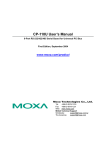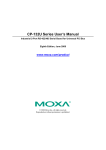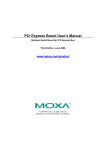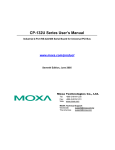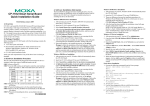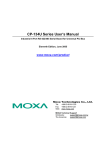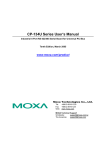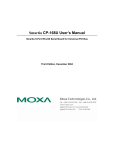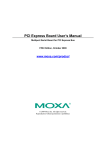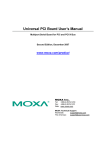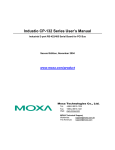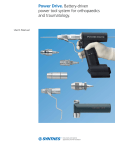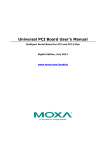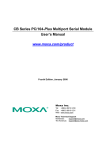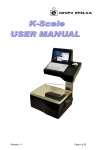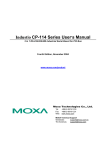Download CP-118U User`s Manual
Transcript
CP-118U User’s Manual 8-Port RS-232/422/485 Serial Board for Universal PCI Bus Fourth Edition, June 2005 www.moxa.com/product Moxa Technologies Co., Ltd. Tel: +886-2-8919-1230 Fax: +886-2-8919-1231 Web: www.moxa.com MOXA Technical Support [email protected] Worldwide: [email protected] The Americas CP-118U User’s Manual The software described in this manual is furnished under a license agreement and may be used only in accordance with the terms of that agreement. Copyright Notice Copyright © 2005 Moxa Technologies Co., Ltd. All rights reserved. Reproduction without permission is prohibited. Trademarks MOXA is a registered trademark of The Moxa Group. All other trademarks or registered marks in this manual belong to their respective manufacturers. Disclaimer Information in this document is subject to change without notice and does not represent a commitment on the part of Moxa. Moxa provides this document “as is,” without warranty of any kind, either expressed or implied, including, but not limited to, its particular purpose. Moxa reserves the right to make improvements and/or changes to this manual, or to the products and/or the programs described in this manual, at any time. Information provided in this manual is intended to be accurate and reliable. However, Moxa assumes no responsibility for its use, or for any infringements on the rights of third parties that may result from its use. This product might include unintentional technical or typographical errors. Changes are periodically made to the information herein to correct such errors, and these changes are incorporated into new editions of the publication. Table of Contents Chapter 1 Introduction ..................................................................................................1-1 Overview.................................................................................................................................. 1-2 Applications ............................................................................................................................. 1-3 Features.................................................................................................................................... 1-3 Package Checklist .................................................................................................................... 1-3 Installation Flowchart .............................................................................................................. 1-4 Chapter 2 Hardware Installation...................................................................................2-1 CP-118U Block Diagram ......................................................................................................... 2-2 DIP Switch Settings ................................................................................................................. 2-2 Plugging the Board into an Expansion Slot ............................................................................. 2-3 Chapter 3 Software Installation ....................................................................................3-1 Windows Drivers ..................................................................................................................... 3-2 Windows 2003/XP........................................................................................................ 3-3 Windows 2000............................................................................................................ 3-14 Windows 95/98........................................................................................................... 3-26 Windows NT .............................................................................................................. 3-38 Non-Windows Drivers ........................................................................................................... 3-45 DOS ............................................................................................................................ 3-45 Linux........................................................................................................................... 3-48 SCO ............................................................................................................................ 3-50 Chapter 4 Serial Programming Tools ..........................................................................4-1 MOXA PComm ....................................................................................................................... 4-2 Installing PComm ......................................................................................................... 4-2 PComm Programming Library ..................................................................................... 4-2 Utilities .................................................................................................................................... 4-3 Diagnostic (for MOXA boards only)............................................................................ 4-3 Monitor (for Moxa boards under Windows NT/2000/XP/2003) .................................. 4-4 Terminal Emulator........................................................................................................ 4-5 RS-485 Programming .............................................................................................................. 4-5 ADDC™....................................................................................................................... 4-5 Chapter 5 Pin Assignments ..........................................................................................5-1 Board Side Pin Assignments—Female DB62.......................................................................... 5-2 RS-232.......................................................................................................................... 5-2 RS-422 and 4-wire RS-485........................................................................................... 5-2 2-wire RS-485............................................................................................................... 5-3 Device Side Pin Assignments .................................................................................................. 5-3 Male DB9 (Opt8-D/Opt8-M9)...................................................................................... 5-3 Male DB25 (Opt8B/C) ................................................................................................. 5-4 Female DB25 (Opt8A/S) .............................................................................................. 5-4 RJ45 (Opt8-RJ45)......................................................................................................... 5-5 Chapter 6 Troubleshooting...........................................................................................6-1 General Troubleshooting.......................................................................................................... 6-1 Windows NT............................................................................................................................ 6-2 Windows 95/98 ........................................................................................................................ 6-2 Appendix A Technical Reference ................................................................................... A-1 Product Specifications ............................................................................................................ A-1 PCI .......................................................................................................................................... A-2 MOXA UART......................................................................................................................... A-2 Appendix B Service Information..................................................................................... B-1 MOXA Internet Services..........................................................................................................B-2 Problem Report Form ..............................................................................................................B-3 Product Return Procedure ........................................................................................................B-4 1 Chapter 1 Introduction Moxa’s CP-118U Universal PCI serial board meets the new slot standard for expansion boards, and works with both 3.3V and 5V PCI slots. The board has eight independent RS-232/422/485 serial ports for connecting data acquisition equipment and other serial devices to a PC. The following topics are covered in this chapter: Overview Applications Features Package Checklist Installation Flowchart CP-118U User’s Manual Introduction Overview Smartio—The Smart Multiport Async Solution CP-118U is one of the newest members of Moxa’s well-known Smartio series of multiport serial boards, in which Smartio stands for Smart Multiport serial I/O solution. The 8-port RS-232/422/485 CP-118U board is designed for the plug-and-play 32-bit PCI bus, and is an economical solution for connecting terminals, modems, printers, scanners, cash registers, bar code readers, keypads, numeric displays, electronic scales, data acquisition equipment, and many other serial devices for the PC and compatible systems. The Smartio device driver makes full use of the 128 byte Tx/Rx FIFO and on-chip H/W and S/W flow control. Your applications will be capable of transmitting data without loss at speeds as high as 921.6 Kbps, providing a reliable, high performance solution for multiport serial communications. PCI Solution The CP-118U board complies with PCI Spec. 2.1. The serial transmission mode (RS-232, RS-422, 2-wire RS-485, or 4-wire RS-485) for each port is set with onboard switches, but the ports’ transmission parameters are configured after the board is installed. The IRQ and I/O addresses are assigned automatically by the PCI BIOS. For this reason, the board MUST be plugged into the computer before installing the driver. For more PCI information, refer to the “Technical Reference” appendix. Surge Protection The CP-118U board comes with built-in 15 KV ESD surge protection to prevent damage to the board from lightning or high potential voltage. The surge protection feature makes the CP-118U board suitable for industrial, factory-type applications, and for use with applications that are subject to severe weather conditions. ADDC™ (Automatic Data Direction Control) for RS-485 To make 2-wire RS-485 half-duplex connections easier to manage, ADDC™ (Automatic Data Direction Control) intelligence is built into the CP-118U board, eliminating the need for software interference. This means that Windows applications can be set up to manage RS-485 ports without writing additional code to control the half-duplex protocol. Operating System Support The CP-118U board is compatible with all major industrial platforms, including Windows 2000/XP/2003, Windows NT, Windows 95/98/Me, DOS, and Linux. MOXA device drivers are provided for smoother installation, configuration, and performance. In this manual, we give installation details for Windows 2003/XP, Windows 2000, Windows NT, Windows 95/98, DOS, Linux, and SCO. Visit Moxa’s website at www.moxa.com to download the latest drivers and user’s manuals for all of Moxa’s products. Universal PCI The 32/64-bit PCI local bus specification requires that PCI hardware be compatible with both 3.3V and 5V connector types. Moxa’s universal PCI cards can be plugged into 3.3V or 5V, and 32-bit or 64-bit slots. MOXA Serial Comm Tool For application development, MOXA provides an easy-to-use serial communication library called PComm that runs under Windows NT/2000/XP/2003/95/98. Use this library to develop your own applications with Visual Basic, Visual C++, Borland Delphi, etc. Utilities, such as Data Scope, Monitor, Terminal Emulator, and Diagnostics are included to make it easier to debug, monitor communication status, provide terminal emulation, and transfer files. 1-2 CP-118U User’s Manual Introduction Applications The CP-118U board is suitable for many different applications, including: y y y y y y y y Internet/Intranet Connections Remote Access Multi-user Applications Industrial Automation Office Automation Telecommunications PC-based Vending Machines and Kiosks POS (Point-of-Sale) Systems Features The CP-118U board has the following outstanding features: y y y y y y y y y 8 independent RS-232/422/RS-485 serial ports Supports Universal PCI Data flow LED display onboard MOXA UART with 128-byte FIFO driver 50 bps to 921.6 Kbps transmission speed Supports both 4-wire and 2-wire RS-485 2-wire RS-485 data control with ADDC™ Embedded 15 KV ESD surge protection Drivers for all major industrial platforms—Windows 2000/XP/2003, Windows NT, Windows 95/98, Windows XP Embedded, Linux, FreeBSD, SCO Package Checklist The following items are included in the CP-118U package: y y y CP-118U 8-port serial board Documentation and Software CD-ROM Quick Installation Guide NOTE: Notify your sales representative if any of the above items are missing or damaged. 1-3 CP-118U User’s Manual Introduction Installation Flowchart The following flowchart gives a brief summary of the procedure you should follow to install the CP-118U board and which chapters to refer to for more detailed information: Use the onboard DIP Switches to select the data transmission mode for each port. Chapter 2, “Hardware Installation” Install the board in a PCI or PCI-X expansion slot. Chapter 2, “Hardware Installation” Install the driver and configure the board and ports. Chapter 3, “Software Installation” Connect the serial devices to the CP-118U board’s serial ports. Chapter 5, “Pin Assignments” Restart the system, and check the driver initialization status. Chapter 3, “Software Installation” Develop and run your serial communication applications Chapter 4, “Serial Programming Tools” 1-4 2 Chapter 2 Hardware Installation The CP-118U Series hardware installation procedure is described in this chapter. Since the CP-118U board’s IRQ number and I/O addresses are assigned automatically by the PCI BIOS, the board MUST be plugged in before installing the driver. The following topics are covered in this chapter: CP-118U Block Diagram DIP Switch Settings Plugging the Board into an Expansion Slot CP-118U User’s Manual Hardware Installation CP-118U Block Diagram 135 mm [5.31 in ] JP1 l JP8 C P-1 18U 121 mm [4.76 in] 82 mm [3.23 in ] MU860 41.7 mm [1.64 in ] NOTE: Use JP1/2/3/4/5/6/7/8 to activate the Termination Resistors for ports 1/2/3/4/5/6/7/8. Open Termination Resistor is NOT active Short Termination Resistor is ACTIVE DIP Switch Settings CP-118U has three onboard DIP Switch arrays, each with 8 switches, referred to below and on the board (see the above block diagram) as S1, S2, and S3. The switches are used to select one of four serial interfaces—RS-232, RS-422, 4-wire RS-485, 2-wire RS-485—for each of the eight ports. Note that S3 selects between RS-232 and RS-422/485, S2 selects between RS-422 and RS-485, and S3 selects between 2-wire and 4-wire RS-485. Mode RS-232 RS-422 4-Wire RS-485 2-Wire RS-485 S1 ----ON OFF S2 --ON OFF OFF 2-2 S3 ON OFF OFF OFF CP-118U User’s Manual Hardware Installation Plugging the Board into an Expansion Slot Since the CP-118U board’s IRQ number and I/O address are automatically assigned by the PCI BIOS, the board MUST be plugged into one of the computer’s expansion slots before installing the driver. Step 1: Power off the PC. WARNING To avoid damaging your system and board, make sure your computer is turned off before installing the board. Step 2: Remove the PC’s cover. Step 3: Remove the slot cover bracket if there is one. Step 4: Use the onboard DIP Switches to set the transmission mode for each port (see the previous section for details). Step 5: Plug the CP-118U board firmly into a free 32-bit PCI slot. Step 6: Fasten the holding screw to fix the control board in place. Step 7: Replace the PC’s cover. Step 8: Power on the PC. The BIOS will automatically set the IRQ and I/O address. NOTE Each Moxa Universal PCI or PCI board uses one unique IRQ and I/O address, both of which are assigned automatically by the PCI BIOS. Step 9: Proceed with the software installation discussed in the next chapter, “Software Installation.” 2-3 3 Chapter 3 Software Installation In this chapter, installation, configuration, and update/removal procedures for the driver are given for Windows (2003/XP, 2000, 98/95, NT), DOS, Linux, and SCO. Before proceeding with the software installation, complete the hardware installation discussed in the previous chapter, “Hardware Installation.” Refer to the next chapter, “Serial Programming Tools,” for information about developing your own serial programming applications. Note that up to 4 CP-118U boards can be installed in one system, provided sufficient I/O address and IRQ number resources are available. Windows 2000/XP/2003, Windows XP Embedded, Windows NT, Windows 95/98, DOS, FreeBSD, Linux, and SCO drivers can be downloaded from the Moxa website. The following topics are covered in this chapter: Windows Drivers ¾ Windows 2003/XP ¾ Windows 2000 ¾ Windows 95/98 ¾ Windows NT Non-Windows Drivers ¾ DOS ¾ Linux ¾ SCO CP-118U User’s Manual Software Installation Windows Drivers MOXA provides drivers that allow you to use the following serial board products under Windows 2003/XP/2000, Windows XP Embedded, Windows 98/95, and Windows NT. y y y y Universal PCI Boards: CP-118U, CP-168U, CP-104UL, CP-104JU, CP-102U, CP-102UL, CP-134U, CP-134U-I, CP-132UL, CP-132UL-I V2 (CP-132U-I V1) PCI Boards: C168H/PCI, C104H/PCI, C104HS/PCI, CP-114, CP-114I, CP-114S, CP-114IS, CP-132, CP-132I, CP-132S, CP-132IS ISA Boards: C168H, C168HS, C168P, C104H, C104HS, C104P, CI-104J, CI-104JS, CI-134, CI-134I, CI-134IS, CI-132, CI-132I, CI-132IS cPCI Boards: CT-114I The overall procedure for installing the Windows drivers for the CP-118U Series boards is summarized in the flowchart at the right. Note that except for Windows NT, a newly installed board will be detected automatically by the Windows OS when it boots up. Plug the CP-118U Series board into an empty PCI or PCI-X slot. See the Hardware Installation chapter. Turn on your PC. Windows will automatically detect the board (except for Windows NT). Driver already installed? No Install the driver from the Documentation and Software CD. See the Installing the Driver for the First Time subsection for detailed instructions. Configure the board’s ports. See the Configuring the Ports subsection for detailed instructions. The CP-118U board and ports are ready to use. 3-2 Yes CP-118U User’s Manual Software Installation Windows 2003/XP In this section, we describe the installation procedure for Windows XP. The installation procedure for Windows 2003 is similar. Windows 2003/XP support up to 256 serial ports, from COM1 to COM256. In order to utilize fully Windows 2003/XP’s multi-process/multi-thread advanced features, pure 32-bit Windows 2003/XP device drivers were developed for MOXA multiport boards. The drivers conform to the Win32 COMM API standard. Installing the Driver The following procedure shows how to install the CP-118U driver for the first time under Windows XP. First, make sure the board or boards have already been plugged into the system’s PCI or PCI-X slot(s). NOTE If you have already installed a CP-118U or other MOXA Smartio/Industio board in your computer, and you install additional boards, Windows 2003/XP will automatically detect and install the new board(s) the next time you boot up the computer. In this case, proceed directly to the next section, “Configuring the Ports,” to configure the ports’ serial transmission parameters. 1. After plugging the board into an expansion slot and powering on your PC, Windows XP will automatically detect the new board, and the Found New Hardware window will open in the bottom right corner of the Windows desktop. 2. The Welcome to the Found New Hardware Wizard window will open automatically. Select Install from a list or specific location (Advanced), and then click on Next to continue. 3-3 CP-118U User’s Manual Software Installation 3. Select Search for the best driver in these locations, check Include this location in the search, and then click on Browse. Navigate to the \CP-118U\Software\Win2K-XP-2003 folder on the software CD, and then click on Next to continue. 4. Wait while the installation wizard searches. The next window that opens cautions you that although this software hasn’t passed Windows Logo testing, the driver has been tested and shown that it can support the Windows OS. Click on Continue Anyway to proceed. 3-4 CP-118U User’s Manual Software Installation 5. Wait while the driver software is installed. 6. The next window shows the model name of the board, and indicates that Windows has completed the driver installation. Click on Finish to proceed with the rest of the installation procedure. 3-5 CP-118U User’s Manual Software Installation 7. The Found New Hardware Wizard window will open to help you install the driver for MOXA Port 0. Select Install from a list or specific location (Advanced), and then click on Next to proceed. 8. Select Search for the best driver in these locations, check Include this location in the search, and then click on Browse. If necessary, use the Browse button to navigate to the CP-118U\Software\Win2K-XP-2003 folder, and then click on Next to proceed. 3-6 CP-118U User’s Manual 9. Software Installation Wait while the installation wizard searches. The next window that opens cautions you that although this software hasn’t passed Windows Logo testing, the driver has been tested and shown that it can support the Windows OS. Click on Continue Anyway to proceed. 10. Wait while the wizard installs the software. 3-7 CP-118U User’s Manual Software Installation 11. After all files have been copied to the system, the Completing the Found New Hardware Wizard window will open to indicate that it has finished installing Port 0. Click on Finish to proceed with the rest of the installation. 12. Repeat Step 7 through Step 11 for each of the remaining seven ports. The last port to be installed will be MOXA Port 7, as shown in the following figure. 3-8 CP-118U User’s Manual Software Installation 13. The Found New Hardware pop-up window will reappear to inform you that the hardware was installed successfully. Configuring the Ports After the driver has been installed, use Device Manager to configure the CP-118U serial ports. 1. Click on Start Æ Settings Æ Control Panel Æ System, select the Hardware tab, and then click on Device Manager. 3-9 CP-118U User’s Manual Software Installation 2. Expand the Multi-port serial adapters tab, right click on MOXA CP-118U Series (PCI Bus), and then click on Properties to open the board’s configuration panel. 3. Click on the port you would like to configure to highlight it, and then click on Port Setting. 3-10 CP-118U User’s Manual Software Installation 4. Select a COM number for the port from the Port Number pull-down list. 5. Check the Auto Enumerating COM Number checkbox to map subsequent ports automatically. The port numbers will be assigned in sequence. For example, if COM 3 is assigned to Port 1, then COM 4 (if not already occupied) will be assigned to Port 2, etc. 6. Select an Rx FIFO Trigger from the Rx FIFO Level pull-down list. Rx FIFO trigger levels of High, Middle, and Low are available, with the default set to High (120 bytes). Check Set the change to all ports checkbox to apply this Rx FIFO Trigger to all ports. 7. Select a Tx FIFO Level from the Tx FIFO Level pull-down list. Tx FIFO Levels of High, Middle, and Low are available, with the default set to High (128 bytes). Check Set the change to all ports checkbox to apply the just defined Tx FIFO Size to all ports. CP-118U Tx FIFO High 128 Middle 64 Low 1 Unit: Bytes 8. Rx FIFO 120 60 1 Click on OK to save the port settings, and then click on OK in the Property window to finish the port settings procedure. 3-11 CP-118U User’s Manual Software Installation Using MOXA PComm Utility The PComm Diagnostic program is a useful tool for checking the status of MOXA’s multiport boards. The program can be used to test internal and external IRQ, TxD/RxD, UART, CTS/RTS, DTR/DSR, etc. Use this program to ensure that your MOXA boards and ports are working properly. To start the program, click on Start Æ Programs Æ PComm Lite 2000(XP Ver 1.2) Æ PComm Diagnostic. NOTE The PComm Lite software can downloaded for free from Moxa’s website at www.moxa.com/support/free_downloads.htm. Using Event Log To use the Event Log to check the installation of your MOXA boards, click on Start Æ Settings Æ Control Panel Æ Administrative Tools Æ Event Viewer to enter the Event Viewer utility. Look under the System category to find the latest information relevant to MOXA’s drivers. 3-12 CP-118U User’s Manual Software Installation Removing the Driver 1. To uninstall the driver, click on Start Æ Settings Æ Control Panel Æ System, select the Hardware tab, and then click on Device Manager. Use the mouse to place the cursor over the CP-118U Series board under Multi-port serial adapters, and then click the right mouse button. Select the Uninstall… option. 2. Click on OK to proceed with uninstalling the board. 3-13 CP-118U User’s Manual 3. Software Installation The Device Manager window refreshes automatically, showing that the driver and ports for the CP-118U Series board have been removed. Windows 2000 In this section, we describe the installation procedure for Windows 2000. Windows 2000 supports up to 256 serial ports, from COM1 to COM256. In order to utilize fully Windows 2000’s multi-process and multi-thread advanced features, pure 32-bit Windows 2000 device drivers were developed for MOXA multiport boards. The drivers conform to the Win32 COMM API standard. Installing the Driver for the First Time The following procedure shows how to install the CP-118U driver for the first time under Windows 2000. First, make sure the board or boards have already been plugged into the system’s PCI or PCI-X slot(s). NOTE If you have already installed a CP-118U or other MOXA Smartio/Industio board in your computer, and you install additional boards, Windows 2000 will automatically detect and install the new board(s) the next time you boot up the computer. In this case, proceed directly to the next section, “Configuring the Ports,” to configure the ports’ serial transmission parameters. 3-14 CP-118U User’s Manual Software Installation 1. After plugging the board into an expansion slot and powering on your PC, Windows 2000 will automatically detect the new board, and the Found New Hardware window will open. 2. When the Welcome to the Found New Hardware Wizard window opens, click on Next to continue. 3-15 CP-118U User’s Manual Software Installation 3. Select Search for a suitable driver for my device (recommended), and then click on Next to continue. 4. Select Specify a location and then click on Next to continue. 3-16 CP-118U User’s Manual Software Installation 5. Navigate to the \CP-118U\Software\Win2K-XP-2003 folder on the software CD, and then click on OK to continue. 6. Click on Next to copy the driver files to your system. 3-17 CP-118U User’s Manual Software Installation 7. Wait while the installation wizard searches. The next window that opens cautions you that although this software hasn’t passed Windows Logo testing, the driver has been tested and shown that it can support the Windows OS. Click on Yes to proceed. 8. Wait while the files are copied to your hard drive. 3-18 CP-118U User’s Manual 9. Software Installation The next window shows the model number of the board, and indicates that Windows has completed the driver installation. Click on Finish to continue with the rest of the installation procedure. 10. The Found New Hardware window will reappear and indicate that the board’s ports are being installed. 11. The installation procedure is finished when the window closes. At this point, you can assume that the board and all of its ports have been installed successfully. 3-19 CP-118U User’s Manual Software Installation Configuring the Ports After the driver has been installed, use Device Manager to configure the CP-118U serial ports. 1. Click on Start Æ Settings Æ Control Panel Æ System, select the Hardware tab, and then click on Device Manager. 3-20 CP-118U User’s Manual Software Installation 2. Expand the Multi-port serial adapters tab, right click on MOXA CP-118U Series (PCI Bus), and then click on Properties to open the board’s configuration panel. 3. Basic information about the board is displayed on the General page. Click on the Ports 3-21 CP-118U User’s Manual Software Installation 4. Configuration tab to configure the board’s serial ports. 5. Click on the port you would like to configure to highlight it, and then click on Port Setting. 3-22 CP-118U User’s Manual Software Installation 6. Select a COM number for the port from the Port Number pull-down list. 7. Check the Auto Enumerating COM Number checkbox to map subsequent ports automatically. The port numbers will be assigned in sequence. For example, if COM 3 is assigned to Port 1, then COM 4 (if not already occupied) will be assigned to Port 2, etc. 8. Select an Rx FIFO Trigger from the Rx FIFO Level pull-down list. Rx FIFO trigger levels of High, Middle, and Low are available, with the default set to High (120 bytes). Check Set the change to all ports checkbox to apply this Rx FIFO Trigger to all ports. 9. Select a Tx FIFO Level from the Tx FIFO Level pull-down list. Tx FIFO Levels of High, Middle, and Low are available, with the default set to High (128 bytes). Check Set the change to all ports checkbox to apply the just defined Tx FIFO Size to all ports. CP-118U Tx FIFO High 128 Middle 64 Low 1 Unit: Bytes Rx FIFO 120 60 1 10. Click on OK to save the port settings, and then click on OK in the Property window to finish the port settings procedure. 3-23 CP-118U User’s Manual Software Installation Using MOXA PComm Utility The PComm Diagnostic program is a useful tool for checking the status of MOXA’s multiport boards. The program can be used to test internal and external IRQ, TxD/RxD, UART, CTS/RTS, DTR/DSR, etc. Use this program to ensure that your MOXA boards and ports are working properly. To start the program, click on Start Æ Programs Æ PComm Lite 2000(XP Ver 1.2) Æ PComm Diagnostic. NOTE The PComm Lite software can downloaded for free from Moxa’s website at www.moxa.com/support/free_downloads.htm. Using Event Log To use the Event Log to check the installation of your MOXA boards, click on Start Æ Settings Æ Control Panel Æ Administrative Tools Æ Event Viewer to enter the Event Viewer utility. Look under the System category to find the latest information relevant to MOXA’s drivers. 3-24 CP-118U User’s Manual Software Installation Removing the Driver 1. To uninstall the driver, click on Start Æ Settings Æ Control Panel Æ System, select the Hardware tab, and then click on Device Manager. Use the mouse to place the cursor over the CP-118U Series board under Multi-port serial adapters, and then click the right mouse button. Select the Uninstall… option. 2. Click on OK to proceed with uninstalling the board. 3-25 CP-118U User’s Manual 3. Software Installation The Device Manager window refreshes automatically, showing that the driver and ports for the CP-118U Series board have been removed. Windows 95/98 In this section, we describe the installation procedure for Windows 98. The installation procedure for Windows 95 is similar. The Windows 95/98 driver supports up to 128 serial ports, from COM1 to COM128. To utilize fully the advanced multi-process and multi-thread features of Windows 95/98, pure 32-bit Windows 95/98 virtual device port drivers (VxD) compliant with communication drivers (VCOMM) have been developed for the CP-118U and other MOXA multiport boards. The drivers conform to the Win32 COMM API standard. Installing the Driver for the First Time The following procedure shows how to install the CP-118U driver for the first time under Windows 98. First, make sure the board or boards have already been plugged into the system’s PCI or PCI-X slot(s). NOTE If you have already installed a CP-118U or other MOXA Smartio/Industio board in your computer, and you install additional boards, Windows 98/95 will automatically detect and install the new board(s) the next time you boot up the computer. In this case, proceed directly to the next section, “Configuring the Ports,” to configure the ports’ serial transmission parameters. 3-26 CP-118U User’s Manual Software Installation 1. After plugging the board into an expansion slot and powering on your PC, Windows 98 will automatically detect the new board, and display the Found New Hardware window. When the Add New Hardware Wizard window opens, click on Next to continue. 2. Select Display a list of all the drivers in a specific location, so you can select the driver you want. and then click on Next to proceed. 3-27 CP-118U User’s Manual Software Installation 3. Select Other Devices and then click on Next to proceed. 4. Click on Have Disk. 5. Use the Browse button to navigate to the \CP-118U\Software\Win9x\Windows.95 folder on the Documentation and Software CD, and then click on OK. 3-28 CP-118U User’s Manual Software Installation 6. Click on CP-118U Series [8-23-2004] to highlight it, and then click on Next. 7. Verify that the CP-118U Series driver will be installed, and then click on Next. 3-29 CP-118U User’s Manual Software Installation 8. Basic configuration information will be displayed in the CP-118U Series Installation window. Click on OK to complete the installation of the board. 9. This completes the installation of the CP-118U board. Click on Finish to exit the Add New Hardware Wizard. NOTE If an error message similar to “CP-118U board (BusNo=x, DevNo=x, Port1=COMx) interrupt number is invalid!” pops up, refer to the “Troubleshooting” chapter for solutions. 3-30 CP-118U User’s Manual Software Installation Configuring the Ports Follow the procedures given below to re-configure the board’s COM ports. Since CP-118U is a Universal PCI board, when a new board is added or an existing board is removed, the board’s configuration will be added or removed automatically by the operating system when you restart the PC. 1. Open the Control Panel and the double click on the System icon. 2. Select the Device Manager tab, click on the desired CP-118U board under Moxa Smartio/Industio multiport board to highlight it, and then click on Properties. 3-31 CP-118U User’s Manual Software Installation 3. Basic information about the board is displayed on the General page. Click on the Ports Configuration tab to configure the board’s serial ports. 4. Click on the port you would like to configure to highlight it, and then click on Port Setting. 3-32 CP-118U User’s Manual Software Installation 5. Select a COM number for the port from the Port Number pull-down list. 6. Check the Auto Enumerating COM Number checkbox to map subsequent ports automatically. The port numbers will be assigned in sequence. For example, if COM3 is assigned to Port 1, then COM4 (if not already occupied) will be assigned to Port 2, etc. 7. Select an Rx FIFO Trigger from the Rx FIFO Level pull-down list. Rx FIFO trigger levels of High, Middle, and Low are available, with the default set to High (120 bytes). Check Set the change to all ports checkbox to apply this Rx FIFO Trigger to all ports. 8. Select a Tx FIFO Level from the Tx FIFO Level pull-down list. Tx FIFO Levels of High, Middle, and Low are available, with the default set to High (128 bytes). Check Set the change to all ports checkbox to apply the just defined Tx FIFO Size to all ports. CP-118U Tx FIFO High 128 Middle 64 Low 1 Unit: Bytes 9. Rx FIFO 120 60 1 Click on OK to save the port settings, and then click on OK in the Property window to finish the port settings procedure. Updating the Driver This section explains how to update the Windows 98 driver. 1. Open the Control Panel, click on the System icon, and select the Device Manager tab. 3-33 CP-118U User’s Manual Software Installation 2. Click on a MOXA CP-118U board under Moxa Smartio/Industio multiport board to highlight it, and then click on Properties. 3. Select the Driver tab, and click on Update Driver…. 3-34 CP-118U User’s Manual Software Installation 4. Click on Next. 5. Select Display a list of all the drivers in a specific location, so you can select the driver you want., and then click on Next. 3-35 CP-118U User’s Manual Software Installation 6. In the next window, the CP-118U Series option should already be highlighted. Click on Have Disk… and then navigate to the folder that contains the new driver file. 7. Follow the on-screen instructions to complete the driver update procedure. 3-36 CP-118U User’s Manual Software Installation Removing the Driver This section explains how to remove the CP-118U driver. 1. Open the Control Panel, double click on the Add/Remove Programs icon, and then select the Install/Uninstall tab. 2. Click on the MOXA Smartio/Industio Driver option and then click on Add/Remove to start the driver removal process. 3. Click on Yes to confirm that you want to remove the driver. 4. Click on OK. 3-37 CP-118U User’s Manual Software Installation Windows NT Windows NT supports up to 256 serial ports, from COM1 to COM256. To utilize fully Windows NT’s multi-process and multi-thread advanced features, pure 32-bit Windows NT device drivers were developed for the CP-118U boards and other MOXA multiport boards. The drivers conform to the Win32 COMM API standard. Installing the Driver for the First Time The following procedure explains how to install the Smartio CP-118U driver for the first time. First make sure the board or boards are already plugged into the system’s PCI slot(s). 1. Log into NT as Administrator. 2. Copy the Windows.nt folder, located under \CP-118U\Software\WinNT on the Documentation and Software CD, to your computer’s hard disk (under the C: drive, for example). 3. Open the Control Panel, click on the Network icon, and select the Adapters tab. 4. Click on Add and then Have Disk… to open the Select Network Adapter window. 5. Specify the exact path and file name of the driver file, C:\Windows.nt, in the example shown here, and then click on OK to proceed. 3-38 CP-118U User’s Manual Software Installation 6. Select MOXA Smartio/Industio Family multiport board in the Select OEM Option window, and then click on OK to start installing the driver. 7. The Moxa Smartio/Industio Configuration Panel window appears. Click on Add to open the Property configuration window to change port settings and set advanced FIFO configuration options. 8. Continue from Step 3 in the next section, “Configuring the Ports.” Configuring the Ports Follow the instructions in this subsection if the CP-118U Windows NT driver is already installed, and you wish to re-configure a board’s ports or configure the ports of a newly installed board. In addition to the procedures listed below, you may also click on Start Æ Programs Æ MOXA Utility Æ MOXA Smartio/Industio Configuration Panel Æ Property, and then refer to the instructions in the previous section, “Installing the Driver for the First Time.” 3-39 CP-118U User’s Manual Software Installation 1. Open the Control Panel, click on the Network icon, and then select the Adapters tab. Click on MOXA Smartio/Industio Family Adapter to highlight it, and then click on Properties. 2. Select the board whose ports you wish to configure to highlight it, and then click on Property. 3. Select the just installed CP-118U board from the Board Type pull-down list, click on a specific port to highlight it, and then click on Port Setting to configure the port. 3-40 CP-118U User’s Manual Software Installation 4. Select a COM number for the port from the Port Number pull-down list. 5. Check the Auto Enumerating COM Number checkbox to map subsequent ports automatically. The port numbers will be assigned in sequence. For example, if COM3 is assigned to Port 1, then COM4 (if not already occupied) will be assigned to Port 2, etc. 6. Select an Rx FIFO Trigger from the Rx FIFO Level pull-down list. Rx FIFO trigger levels of High, Middle, and Low are available, with the default set to High (120 bytes). Check Set the change to all ports checkbox to apply this Rx FIFO Trigger to all ports. 7. Select a Tx FIFO Level from the Tx FIFO Level pull-down list. Tx FIFO Levels of High, Middle, and Low are available, with the default set to High (128 bytes). Check Set the change to all ports checkbox to apply the just defined Tx FIFO Size to all ports. CP-118U Tx FIFO High 128 Middle 64 Low 1 Unit: Bytes 3-41 Rx FIFO 120 60 1 CP-118U User’s Manual Software Installation 8. Click on OK to save the settings, and then click on OK in the Property window to complete the port settings and return to the MOXA Smartio/Industio Configuration Panel window. The just configured CP-118U board will be listed, as shown below. Click on OK to return to the Network window. 9. Click on Close to close the Network window. 10. Restart the PC to activate the new settings. 3-42 CP-118U User’s Manual Software Installation NOTE The driver configuration will NOT take effect until you restart the PC. Using Event Log Once the system restarts, you may check the event log recorded by the MOXA driver to verify that the board’s ports have been initialized successfully. To view the event log, enter the Administrative group, click the Event Viewer icon, and then select Log and System to check a message similar to “MOXA CP-118U board, with first serial port COM3, has been enabled” for each newly configured board. NOTE If an error message similar to “Cannot find any configured MOXA Smartio/Industio series board!” pops up, refer to the Troubleshooting chapter for possible solutions. Removing a CP-118U Board To remove a CP-118U board, first shut down your PC, and then physically remove the board from the PCI or PCI-X slot. The next time you start up the PC, the system will automatically remove the configuration for the board. You do not need to click the Remove button in the Moxa Smartio/Industio Configuration Panel. 3-43 CP-118U User’s Manual Software Installation Removing the Driver To remove the CP-118U driver: 1. Open the Control Panel, click on the Network icon, and select the Adapters tab. 2. Click on MOXA Smartio/Industio Family Adapter in the Network Adapters list to highlight it. 3. Click on Remove. 4. Click on Close, and then restart the system. Updating the Driver To update the CP-118U driver: 1. Remove the current driver (see the previous subsection for instructions). 2. Restart the system. 3. Install the new driver. Refer to the “Installing the Driver for the First Time” section for instructions. 3-44 CP-118U User’s Manual Software Installation Non-Windows Drivers Drivers are provided for DOS, Linux, and SCO. DOS MOXA DOS API-232 is a software package that assists users in developing new programs, or debugging existing programs for serial communications. This section explains how to install the package, how to set up the driver, and how to load or unload the driver. MOXA provides drivers that allow you to use the following serial board products under DOS: y y y y Universal PCI Boards: CP-118U, CP-168U, CP-104UL, CP-104JU, CP-102U, CP-102UL, CP-134U, CP-134U-I, CP-132UL, CP-132UL-I V2(CP-132U-I V1) PCI Boards: C168H/PCI, C104H/PCI, C104HS/PCI, CP-114, CP-114I, CP-114S, CP-114IS, CP-132, CP-132I, CP-132S, CP-132IS ISA Boards: C168H, C168HS, C168P, C104H, C104HS, C104P, CI-104J, CI-104JS, CI-134, CI-134I, CI-134IS, CI-132, CI-132I, CI-132IS cPCI Boards: CT-114I Installing the Driver 1. Run the installation program, DOSINST.EXE from the \Software\DOS folder on the Documentation and Software CD. Specify the target API-232 directory (e.g. C:\MOXA) to which the driver will be copied. Press F2 to start the installation. 2. After the installation is complete, a window will open to ask if you want to run SETUP.EXE. Press Y to run the program. 3-45 CP-118U User’s Manual Software Installation Setting up the Driver This section covers some of the setup program’s most frequently used functions. For complete details, press F1 to open the on-line help file. 1. Run BIN\SETUP.EXE. 2. Press Enter to select the model name of the MOXA board you are installing. 3. A window will open displaying basic configuration information for all boards of this type currently installed in the system. Press PgDn to configure the port settings. 3-46 CP-118U User’s Manual Software Installation 4. You may enter or modify the settings of each port at this stage. The values displayed first are the port’s initial values that were set up when the driver was installed. 5. Press F10 to save the changes and exit the SETUP program. Legends In this section, we explain the meaning of some of the fields and functions. Port number This is the ID of the port. Application software uses port number (ID) when referring to a port. Port numbers can be set to any number between 0 and 255 (inclusive). However, you must ensure that each port is assigned a unique port number. If you are developing your own application software, then you may want to select port numbers that take into consideration the structure of the program. TxD buffer size The TxD buffer is the transmission (output) buffer allocated by the system for each port. RxD buffer size The RxD buffer is the receiving (input) buffer allocated by the system for each port. 3-47 CP-118U User’s Manual Software Installation F5 Group Edit This is a convenient function that allows you to edit the configuration of several ports at one time as a group. Loading the Driver After completing the setup procedure, run BIN\DP-DRV.EXE from the DOS prompt to load the driver. The driver will automatically detect the boards that have already been installed. If one or more board is detected, you will see a message similar the following: Smartio/Industio Family DOS driver Version 1.5 Setup driver … CP-118U series (Bus= x ,Dev=y) : OK! Device driver setup O.K. This means that the CP-118U Series driver has been installed properly. At this point, you may execute applications that support API-232 functions, or start developing applications using the API-232 library. Unloading the Driver To unload (release) the driver from memory, type DP-DRV/Q at the DOS prompt and then press Enter. Linux MOXA provides drivers that allow you to use the following serial board products under Linux. y y y y Universal PCI Boards: CP-118U,CP-168U, CP-104UL, CP-104JU, CP-102U, CP-102UL, CP-134U, CP-134U-I, CP-132UL, CP-132UL-I V2(CP-132U-I V1) PCI Boards: C168H/PCI, C104H/PCI, C104HS/PCI, CP-114, CP-114I, CP-114S, CP-114IS, CP-132, CP-132I, CP-132S, CP-132IS ISA Boards: C168H, C168HS, C168P, C104H, C104HS, C104P, CI-104J, CI-104JS, CI-134, CI-134I, CI-134IS, CI-132, CI-132I, CI-132IS cPCI Boards: CT-114I 3-48 CP-118U User’s Manual Software Installation Execute the following commands from the Linux prompt: 1. #mount /dev/cdrom /mnt/cdrom #cd / #mkdir moxa 2. #cd moxa #cp /mnt/cdrom/<driver directory>/mxser.tgz . 3. #tar xvfz mxser.tgz 4. #cd mxser #make clean; make install 5. #cd /moxa/mxser/driver #./msmkod 6. #modprobe mxser (If you install ISA Boards, use the command # insmod mxser ioaddr=0x???, 0x???, 0x???, 0x??? <- 1st ISA, 2nd ISA, 3rd ISA, 4th ISA) Using /lib/modules/2.4.20-8/kernel/drivers/char/mxser.o Warning: loading /lib/modules/2.4.20-8/kernel/drivers/char/mxser.o will taint the kernel: no license See http://www.tux.org/lkml/#export-tainted for information about tainted modules MOXA Smartio/Industio family driver version 1.7 Tty devices major number = 30, callout devices major number = 35 Found MOXA CP-118U series board (BusNo=2,DevNo=13) Module mxser loaded, with warnings 7. Use the Moxa diagnostic utility to verify the driver status: #cd /moxa/mxser/utility/diag #./msdiag = MOXA Smartio/Industio Family Multiport Board Status Utility(1.1)= Tty Device Major Number= 30. Callout device Major Number= 35. Board 1 : CP-118U series (BusNo=2, DevNo=13) Port 1: 0xac00, max. baud rate = 230400 bps. Port 2: 0xac08, max. baud rate = 230400 bps. Port 3: 0xac10, max. baud rate = 230400 bps. Port 4: 0xac18, max. baud rate = 230400 bps. Port 5: 0xac20, max. baud rate = 230400 bps. Port 6: 0xac28, max. baud rate = 230400 bps. Port 7: 0xac30, max. baud rate = 230400 bps. Port 8: 0xac38, max. baud rate = 230400 bps. 8. Use the Moxa terminal utility to test the tty ports: #cd /moxa/mxser/utility/term #./msterm 3-49 CP-118U User’s Manual Software Installation SCO MOXA provides drivers that allow you to use the following serial board products under Linux. y y y Universal PCI Boards: CP-118U, CP-168U, CP-104UL, CP-104JU, CP-102U, CP-102UL PCI Boards: C168H/PCI, C104H/PCI, C104HS/PCI ISA Boards: C168H, C168HS, C168P, C104H, C104HS, C104P, CI-104J, CI-104JS Follow the steps given in this section to install the SCO driver. Note that the SCO driver provided by Moxa only supports RS-232. Consequently, the SCO driver will only work with CP-118U ports that are configured for RS-232. MOXA provides drivers for the following versions of SCO: y y y SCO OpenServer SCO UnixWare 7 SCO UnixWare 2.1 The following steps are for installing the driver under SCO OpenServer. The installation procedures for SCO UnixWare 7 and SCO UnixWare 2.1 are similar. 1. Copy the driver file .tar to your host. 2. #tar xvf <driver tar file> /tmp/moxa/mxintall /tmp/moxa/sco.tar 3. # cd/tmp/mxinstall # ./mxinstall 4. The window shown below will open next. Press any key to continue. Copyright© 2004 Moxa Technologies Co., Ltd. All Rights Reserved. MOXA Smartio Family Device Driver Installation (Ver. 1.6) For SCO UNIX System V/386 Release 3.2 Tar files, please wait…..O.K. Press any key to continue 3-50 CP-118U User’s Manual 5. Software Installation The Basic Configuration window will open next. You can install up to four MOXA Smartio Multiport Serial Boards under SCO Unix/SCO Open Server. MOXA Smartio Family Installation Utility (Ver 1.6) Smartio Family Basic Configuration Board No. Board Type I/O Address Interrupt Bus/Dev No. 1 None ------------- ------------- ------------- 2 None ------------- ------------- ------------- 3 None ------------- ------------- ------------- 4 None ------------- ------------- ------------- PgDn: getty Setting Enter: Confirm Input Value 6. Esc: Exit Tab: Change Item Press Enter to select the MOXA Multiport Serial Board you installed. For example, select “CP-118U” and then press Enter. None CP-118U C168 ISA Series C104 ISA Series C168 PCI Series C104 PCI Series CP-104U Series CP-168U Series CP-104JU Series CP-102U CP-102UL 7. The board’s basic information, such as I/O address, Bus No., and Device No., will be shown next. Resources will be assigned by the SCO system to the PCI board you selected. PCI Boards Selecting 1 I/O Addr= AC00, BusNo=2, DevNo=13 Enter: Select ESC: Exit 3-51 CP-118U User’s Manual 8. Software Installation Press Enter to return to the main screen. Smartio Family Installation Utility (Ver 1.6) Smartio Family Basic Configuration Board No. Board Type I/O Address Interrupt Bus/Dev No. 1 CP-118U AC00 5 2/13 2 None ------------- ------------- ------------- 3 None ------------- ------------- ------------- 4 None ------------- ------------- ------------- PgDn: getty Setting Enter: Confirm Input Value 9. Esc: Exit Tab: Change Item Press Esc to save the configuration and exit. Save configuration changes? (Y/N) 10. The driver files will be copied to the SCO system. Press any key to continue. --------------------------[Message] -------------------------Copying driver files and configuring system. Please wait…. Press any key to continue! _ 11. Press Y to rebuild the system. --------------------------[Message] -------------------------Do you want to rebuild the system? (y/n)_ 12. The window shown below will open next. --------------------------[Message] -------------------------Do you want to rebuild the system? (y/n)_ Rebuilding kernel. Please wait…. 13. After the system is rebuilt, the system will return to shell command. At this point, you can begin to use your MOXA Smartio Multiport Serial Board. --------------------------[Message] -------------------------Do you want to rebuild the system? (y/n)_ Rebuilding kernel. Please wait…. Rebuilding kernel completed. Please remember to manually reboot your system later. Press any key to continue. _ 3-52 4 Chapter 4 Serial Programming Tools Moxa provides an easy to use yet powerful serial programming library, and communication troubleshooting utilities under Windows 2000/XP/2003, Windows 95/98, and Windows NT. The following sections give details about the installation, the library, and the utilities for various platforms. The following topics are covered in this chapter: MOXA PComm ¾ Installing PComm ¾ PComm Programming Library Utilities ¾ Diagnostic (for Moxa boards only) ¾ Monitor (for Moxa boards under Windows NT/2000/XP/2003) ¾ Terminal Emulator RS-485 Programming ¾ ADDC™ CP-118U User’s Manual Serial Programming Tools MOXA PComm PComm, a professional serial comm tool for PCs, is a software package that runs under Windows NT/2000/XP/2003/95/98. PComm provides: y y y y A powerful serial communication library that simplifies serial programming tasks for most popular programming languages. The serial communication library is useful for developing applications for data communications, remote access, data acquisition, and industrial control under Windows NT/2000/XP/2003/95/98, and is a simpler programming solution compared to the more complex Windows Win32 COMM API. Useful utilities such as diagnostic, monitor, and terminal emulator. Illustrative sample programs. Comprehensive on-line documentation. Installing PComm To install PComm, run \Setup.exe from the Documentation and Software CD. Note that the PComm diagnostic and monitor utilities are for Moxa boards only. To use these utilities, you must have a Moxa board and the appropriate Windows (95/98/NT/2000/XP/2003) device driver installed in your system. See the “Software Installation” chapter for instructions on how to install the drivers. After installing PComm, click on Start, select Program Files, and then the PComm Lite group to select from the list of utilities and documents. PComm Programming Library The serial communication library helps you develop serial communications programs for any COM port that complies with the Microsoft Win32 API. This library facilitates the implementation of multi-process, multi-thread serial communication programs, and greatly reduces the time required to develop applications. For a complete description of the library functions and sample programs for Visual C++, Visual Basic, and Delphi, check the help file and the sample programs in the PComm directory. 4-2 CP-118U User’s Manual Serial Programming Tools Utilities In this section, we give brief descriptions of each utility. For more information about these utilities, read the on-line help from the Documentation and Software CD. Diagnostic (for MOXA boards only) This convenient diagnostic program, which only works with MOXA boards and ports, provides internal and external testing of IRQ, TxD/RxD, UART, CTS/RTS, DTR/DSR, DTR/DCD, etc. The diagnostic program allows the user to check the function of both software and hardware. To run the Diagnostic program, click on Start Æ Program Æ PComm Lite Æ Diagnostic. A typical test report for a Moxa board is shown below. 4-3 CP-118U User’s Manual Serial Programming Tools Monitor (for Moxa boards under Windows NT/2000/XP/2003) This useful port status monitoring program allows you to monitor data transmission of selected Moxa COM ports. The program monitors data transmission/receiving throughput, and communication line status, with data updated and displayed on the screen at regular time intervals. Click on a specific port to see a graph of the current communication parameters and status of that port. To run the Monitor program, click on Start Æ Program Æ Pcomm Lite Æ Monitor. 4-4 CP-118U User’s Manual Serial Programming Tools Terminal Emulator Use Terminal Emulator to connect to your PC’s serial ports to check if data is being transmitted correctly. Terminal Emulator features multi-windows, and supports VT100 and ANSI terminal types. You can transfer data interactively, send patterns periodically, and transfer files using ASCII, XMODEM, YMODEM, ZMODEM, and KERMIT protocols. To run Terminal Emulator, click on Start Æ Program Æ Pcomm Lite Æ Terminal Emulator. RS-485 Programming If you are using your CP-118U Series board for RS-485 applications, in addition to reading this section, you should also refer to the “Connection Cables and Cable Wiring” chapter for more details about using RS-485. The CP-118U Series supports 2-wire half-duplex RS-485 and 4-wire full duplex RS-485 communication. Ports configured for 2-wire RS-485 use the Data+ and Data- pins for both transmitting and receiving data. Moxa’s own ADDC™ (Automatic Data Direction Control) technology is used to switch between transmitting and receiving. ADDC™ ADDC™ is the best method for switching between transmission and receiving when using 2-wire RS-485. When using ADDC™, additional code is not required to switch between data transmitting and receiving, since the switching mechanism is managed automatically by the board’s built-in intelligent hardware mechanism. This means that RS-485 programming using ADDC™ mode is just as simple and straightforward as RS-232 or RS-422 programming. 4-5 5 Chapter 5 Pin Assignments The CP-118U board has a female DB62 connector on the board, with various connection options available for connecting from the board to your serial devices. In this chapter, we give pin assignments for the board side connector, as well as pin assignments for device side connectors for the different connection options. The CP-118U board supports RS-232, RS-422, 4-wire RS-485, and 2-wire RS-485. Note that the RS-422 standard uses a balanced voltage digital interface to allow 9600 bps communication over cables of up to 4000 feet in length. Ten receivers can be connected to one driver for broadcasting systems. The RS-485 standard is an enhanced version of the RS-422 balanced line standard. It allows multiple drivers and receivers to work on a multidrop network. A maximum of 32 drivers and 32 receivers can be set up on a multidrop network. The CP-118U board supports both 2-wire half-duplex and 4-wire full-duplex RS-485 communications. In 2-wire RS-485, Data+/- pins are used for both data transmitting and receiving. The following topics are covered in this chapter: Board Side Pin Assignments—Female DB62 ¾ RS-232 ¾ RS-422 and 4-wire RS-485 ¾ 2-wire RS-485 Device Side Pin Assignments ¾ Male DB9 (Opt8-D/Opt8-M9) ¾ Male DB25 (Opt8B/C) ¾ Female DB25 (Opt8A/S) ¾ RJ45 (Opt8-RJ45) CP-118U User’s Manual Pin Assignments Board Side Pin Assignments—Female DB62 Port 6 Port 8 Port 7 Port 3 Port 5 Port 4 Port 2 Port 1 21 42 62 1 22 43 GND GND GND GND GND GND RS-232 Port Number Signal 0 1 2 3 4 5 6 7 TxD 1 25 6 30 33 14 38 41 RxD 22 3 27 8 11 35 16 19 RTS 44 47 49 52 54 57 60 62 CTS 43 46 48 51 53 56 59 61 DSR 23 4 28 9 12 36 17 20 GND 32, 40, 45, 50, 55, 58 DCD 24 5 29 10 13 37 18 21 DTR 2 26 7 31 34 15 39 42 Pin Number RS-422 and 4-wire RS-485 Port Number Signal 0 1 2 3 4 5 6 7 TxD+(B) 22 3 27 8 11 35 16 19 TxD-(A) 24 5 29 10 13 37 18 21 RxD+(B) 1 25 6 30 33 14 38 41 RxD-(A) 2 26 7 31 34 15 39 42 GND 32, 40, 45, 50, 55, 58 Pin Number 5-2 CP-118U User’s Manual Pin Assignments 2-wire RS-485 Port Number Signal 0 1 2 3 4 5 6 7 Data+(B) 1 25 6 30 33 14 38 41 Data-(A) 2 26 7 31 34 15 39 42 GND 32, 40, 45, 50, 55, 58 Pin Number Device Side Pin Assignments Male DB9 (Opt8-D/Opt8-M9) 1 5 6 9 Pin RS-232 RS-422 / 4-wire RS-485 2-wire RS-485 1 DCD TxD-(A) --- 2 RxD TxD+(B) --- 3 TxD RxD+(B) Data+(B) 4 DTR RxD-(A) Data-(A) 5 GND GND GND 6 DSR --- --- 7 RTS --- --- 8 CTS --- --- 9 --- --- --- 5-3 CP-118U User’s Manual Pin Assignments Male DB25 (Opt8B/C) 1 14 13 25 Pin RS-232 RS-422 / 4-wire RS-485 2-wire RS-485 2 TxD RxD+(B) Data+(B) 3 RxD TxD+(B) --- 4 RTS --- --- 5 CTS --- --- 6 DSR --- --- 7 GND GND GND 8 DCD TxD-(A) --- 20 DTR RxD-(A) Data-(A) Female DB25 (Opt8A/S) 13 1 25 14 Pin RS-232 RS-422 / 4-wire RS-485 2-wire RS-485 2 RxD TxD+(B) --- 3 TxD RxD+(B) Data+(B) 4 CTS --- --- 5 RTS --- --- 6 DTR RxD-(A) Data-(A) 7 GND GND GND 8 DCD TxD-(A) --- 20 DSR --- --- 5-4 CP-118U User’s Manual Pin Assignments RJ45 (Opt8-RJ45) 1 8 Pin RS-232 RS-422 / 4-wire RS-485 2-wire RS-485 1 DSR --- --- 2 RTS --- --- 3 GND GND GND 4 TxD RxD+(B) Data+(B) 5 RxD TxD+(B) --- 6 DCD TxD-(A) --- 7 CTS --- --- 8 DTR RxD-(A) Data-(A) 5-5 6 Chapter 6 Troubleshooting Common CP-118U Series problems and possible solutions are listed below. If you still have problems after reading this chapter, contact your dealer or Moxa for help, or use the Problem Report Form at the end of this manual to report problems to your dealer. General Troubleshooting 1. The MOXA CP-118U board cannot be detected by the MOXA driver while installing the driver. Hardware causes and solutions: a. b. c. 2. The board is not installed in the computer. Please install it. The board is not properly plugged into the system. If this is the case, re-plug the board into a 32-bit PCI slot. It is also possible that a slot has malfunctioned. In this case, try other slots until you find one that works. The motherboard does not have an available IRQ for the CP-118U Series board. In this case, enter the BIOS and make sure there is an available IRQ under PCI/PnP settings. The MOXA CP-118U board and driver are activated but cannot transfer (transmit/receive) data. Hardware Causes and Solutions: a. b. Make sure the cable wiring is connected correctly. Refer to the “Pin Assignments” chapter for correct cable connections. The cable or the board could be defective. Try other ports, cables, or boards to verify this, or use the PComm Diagnostic utility to test the MOXA board and port conditions. If Diagnostic reports an error, replace the faulty components. Software Causes and Solutions: a. b. CP-118U Series boards will check the line status (CTS) before transmitting data if the RTS/CTS flow control feature is set to Enable in the configuration or application program. Refer to the “Connection Cables and Cable Wiring” chapter for proper wiring diagrams, and check the line status of the suspected port using the diagnostic LED indicators on the mini tester. The board control application might not be written correctly according to the corresponding API of the operating system. To check this problem, run another application that you know is correct, or use the utilities provided by Moxa (such as Pcomm Terminal emulator or HyperTerminal under Windows NT and Windows 95/98). CP-118U User’s Manual Troubleshooting Windows NT This section is specifically for troubleshooting problems for Windows NT. For general problems and solutions, see the previous section, “General Troubleshooting.” 1. After the system reboots, the error message “Another driver in the system, which did not report its resources, has already claimed the interrupt used by xxx.” appears in the Event Log. This indicates the MOXA board was found, but the IRQ is conflicting with another adapter. Check the PCI BIOS IRQ settings first and then select an IRQ that is available. 2. After the system reboots, the error message “Cannot find any configured MOXA Smartio/Industio Series board!” appears in the Event Log. Make sure the PCI board is seated firmly in the expansion slot. 3. The COM number of the CP-118U Series conflicts with others. The COM numbers of different boards happen to be the same. Try changing the COM number mappings. 4. Windows NT system panic (blue screen). This could be caused by an IRQ or memory conflict with other ISA Bus adapters, such as LAN and SCSI boards, or the system BIOS. Refer to the corresponding problem in the previous section, “General Troubleshooting,” for possible solutions. Windows 95/98 This section is specifically for troubleshooting under Windows 95/98. For general problems and solutions, see the previous section, “General Troubleshooting.” 1. The system fails to find the CP-118U Series board! The board(s) is (are) not plugged in properly. 2. The slot the boards are plugged into is defective. Try another slot until you find one that works. The board might be defective. 3. After the system reboots, the error message “CP-118U Series (BusNo=x, DevNo=x, Port1=COMx) interrupt number is invalid!” appears. This indicates that the MOXA board was found, but the IRQ conflicts with another adapter. Make sure the MOXA board’s IRQ does not conflict with other adapters’ IRQ. Check the PCI BIOS IRQ settings and select an available IRQ for MOXA boards. 6-2 A Appendix A Technical Reference Product Specifications Bus interface Number of ports I/O address IRQ Data bits Stop bits Parity Flow Control UART Speed Connector Data signals Surge protection Operating temperature Power requirement Dimensions (W × D) 32-bit PCI 8 Assigned by PCI BIOS Assigned by PCI BIOS 5, 6, 7, 8 1, 1.5, 2 none, even, odd, space, mark RTS/CTS, XON/XOFF Moxa UART (16C550C or compatible) 50 bps to 921.6 Kbps Female DB62 RS-232 TxD, RxD, RTS, CTS, DTR, DSR, DCD, GND RS-422 TxD+(B)/-(A), RxD+(B)/-(A), GND 4-wire RS-485 TxD+(B)/-(A), RxD+(B)/-(A), GND 2-wire RS-485 Data+(B)/-(A), GND 15 KV ESD 0 to 55°C 240 mA max. (+5V, RS-232), 300 mA max. (+5V, RS-422) 135 × 82 mm (5.31 × 3.23 in) CP-118U User’s Manual Technical Reference PCI The 32-bit CP-118U Series board complies with PCI Specifications 2.1, and the IRQ and I/O address hardware configuration is automatically assigned by the PCI BIOS. This means that you must plug in the board before installing the driver. As opposed to ISA slots, different PCI slots in the same PC may have different bus numbers and device numbers with respect to the PCI specifications. The same PCI board will have different system configurations if switched to a different PCI slot; this is called slot-sensitivity or slot-dependency. This may also apply to PCI slots in a PC with a different motherboard, which may use different device number sets. For example, some use 17, 18, 19, and 20 for identifying the respective PCI slots, but some use 11, 12, 13, and 14. Due to slot-dependency, it is necessary to re-configure the driver software once the board is plugged into different PCI slots. Up to 4 CP-118U Series boards are allowed in one system. When installing more than one board, remember the order the boards are installed to distinguish the installed boards from each other. MOXA UART The MOXA UART is an intelligent asynchronous controller that supports one full duplex channel that simultaneously transfers data at a transmission speed of 921.6 Kbps. To increase overall data throughput, special features such as on-chip FIFO and on-chip hardware flow control are used to reduce the number of interrupts to the onboard CPU, helping to prevent data loss. A-2 B Appendix B Service Information This appendix shows you how to contact Moxa for information about this and other products, and how to report problems. In this appendix, we cover the following topics. MOXA Internet Services Problem Report Form Product Return Procedure CP-118U User’s Manual Service Information MOXA Internet Services Customer satisfaction is our number one concern, and to ensure that customers receive the full benefit of our products, Moxa Internet Services has been set up to provide technical support, driver updates, product information, and user’s manual updates. The following services are provided E-mail for technical support [email protected] (Worldwide) [email protected] (The Americas) Moxa Group website for product information, driver downloads, documentation, and more: http://www.moxa.com B-2 CP-118U User’s Manual Service Information Problem Report Form MOXA CP-118U Series Customer name: Company: Tel: Fax: Email: Date: 1. Moxa Product: CP-118U 2. Serial Number: _________________ Problem Description: Please describe the symptoms of the problem as clearly as possible, including any error messages you see. A clearly written description of the problem will allow us to reproduce the symptoms, and expedite the repair of your product. B-3 CP-118U User’s Manual Service Information Product Return Procedure For product repair, exchange, or refund, the customer must: Provide evidence of original purchase. Obtain a Product Return Agreement (PRA) from the sales representative or dealer. Fill out the Problem Report Form (PRF). Include as much detail as possible for a shorter product repair time. Carefully pack the product in an anti-static package, and send it, pre-paid, to the dealer. The PRA should be visible on the outside of the package, and include a description of the problem, along with the return address and telephone number of a technical contact. B-4





















































































